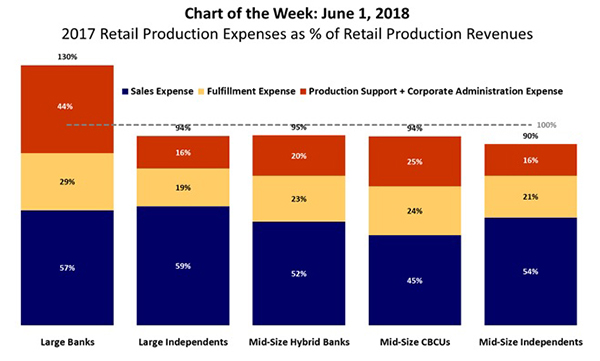
MBA Chart of the Week: 2017 Retail Production Expenses

Source: MBA, STRATMOR Peer Group Roundtables www.mba.org/pgr
The 20th spring cycle of the MBA/STRATMOR Peer Group Roundtables recently concluded. With 105 banks and independent mortgage companies participating in the survey collection, the PGR produces a rich dataset particularly for the retail production channel.
This channel is characterized by production volume originated through in-house loan officers within standard or bank branch network systems (versus third-party originator networks or consumer direct/call centers).
For the retail channel, there were plenty of differences in operating model, geographic distribution, product mix and secondary execution across companies. Some companies reported high revenues and high costs while others had relatively lower revenues and lower costs.
For this week’s chart, in an effort to normalize for these differences, we show total retail production expenses as a percentage of total retail production revenues across five peer groups. Mid-size independents outperformed other peer groups in the retail channel with costs equal to 90 percent of revenues. Large banks struggled to control all costs, particularly production support and corporate overhead, which represented 44 percent of revenues. Across all peer groups except the mid-size community banks and credit unions, more than half of production revenues were used to cover sales costs alone.
Retail revenues include fee income, secondary marketing gains, servicing released premiums, capitalized servicing and net warehouse spread. Retail expenses include sales costs (sales compensation including commissions, overrides, marketing); fulfillment costs (processing, underwriting, closing personnel and other costs); and production support and corporate costs (technology, post-closing functions; secondary; legal; executive; finance).
(Marina Walsh is vice president of industry benchmarking and research with MBA; she can be reached at mwalsh@mba.org.)
